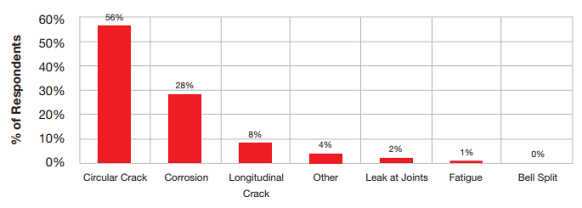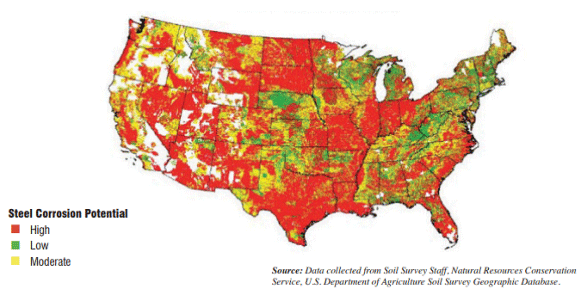A new academic study1 of water main failures in the United States and Canada shows a 27% increase in water main break rates between 2012 and 2018, with corrosive soils cited as a leading contributor.
Research was led by Steven Folkman, a professor at Utah State University (USU) (Logan, Utah, USA) and author of a similar report on water main breaks in 2012. USU is home to both the Buried Structures Laboratory, which has a large-scale testing facility for pipes and underground structures, and the Utah Water Research Laboratory—which is the oldest U.S. university-based water research facility.
Highlights of the latest pipe materials study include data on break rates, as compared to the prior study; the analysis of age and corrosion in failure modes; observations on pressure, delivery demands, and the effects of soil corrosivity; and new metrics for pipe replacement rates.
Survey Respondents
In all, the 2018 survey collected responses from more than 300 utilities, representing ~200,000 mi (321,869 km) of installed water mains. The study gathered respondent input from 48 U.S. states and seven out of 10 Canadian provinces, representing a 49% increase in survey responses and 45% more miles of pipe compared to the 2012 study. The survey recorded 23,803 pipe failures that needed repairs, which represented a significant sample size.
“This is one of the largest surveys conducted on water main breaks, and the results give an accurate representation of water pipe condition and operation in North America,” says Folkman, a registered Professional Engineer and member of the American Water Works Association (AWWA) (Denver, Colorado, USA). “The report can assist in revising pipe service life assumptions used in the past.”
Among respondents who acknowledged a failure, the three most commonly cited modes were a circular crack at 56%, corrosion at 28%; and a longitudinal crack at 8%.

According to Folkman, water main break rates are an important calculation to assess pipe performance and durability, and are the most critical metric used in water infrastructure asset management as well as pipe repair and replacement decision-making.
“This report provides greater insight into the drivers of the aging water infrastructure crisis and offers data which utilities can use to benchmark pipe material performance,” says Folkman, whose expertise includes structural dynamics, linear and nonlinear finite element analysis utilizing soil-to-structure interaction, and testing. “It will be a valuable asset management planning tool for water utilities.”
Role of Corrosive Soils
In the report, Folkman explains that corrosion can contribute to many common failures. The most common failure mode reported in the study was a circumferential crack, which he says is commonly found on cast iron and asbestos cement pipes. Cast iron pipes and asbestos cement pipes comprised 28% and 13%, respectively, of the pipe materials on the studied water mains. Other leading materials included ductile iron at 28% and polyvinyl chloride (PVC) pipe at 22%.
In terms of predicting when corrosion will occur, Folkman refers to findings from separate soil surveys conducted by the U.S. Department of Agriculture (Washington, DC, USA) National Resources Conservation Service. One of the aspects of the soil surveys is a “risk of corrosion” analysis that pertains to the possibility of soil-induced electrochemical or chemical action that corrodes or weakens uncoated steel. The soil is rated either “low,” “moderate,” or “high” based on measurements of moisture, particle size, acidity, and electrical conductivity. “A typical city has a corrosion risk rating somewhere between moderate and high, demonstrating the importance of corrosion mitigation for water systems,” he says.

Of utilities surveyed, 75% reported operating pipes in one or more soil areas with moderate or highly corrosive conditions. “Utilities with a higher percentage of iron pipe may experience a higher percentage of corrosion-related breaks,” Folkman says. “This would especially apply to pipe installed without an increased investment in condition assessment, pipe monitoring, and corrosion control measures. The study found a direct correlation between soil corrosiveness and the break rates of metallic pipes.”
According to Folkman, a cast iron pipe located in highly corrosive soil is expected to have over 20 times the break rate of a similar pipe in low corrosive soil. “Traditionally, the thickness of the iron pipe wall provided the additional corrosion protection,” he writes. “[Cast iron] pipes manufactured after World War II have significantly higher failure rates due to thinner walls. The resulting higher breaks with iron pipes due to corrosive soils is consistent with other research and studies.”
Meanwhile, ductile iron pipe in highly corrosive soil has over 10 times the break rate relative to low corrosive soil. “Because the wall thickness of [ductile iron] pipe has decreased over time, internal and external corrosion are a bigger concern for this pipe product,” Folkman says.
Corrosion Prevention Methods
The survey found that 80% of respondents reported using at least some form of corrosion protection. In order, the top five most common preventive methods used by water main operators are polywrap; anodes or cathodic protection; V-bio polywrap; impressed current; and dielectric coatings.
However, Folkman cautions that many water utilities often do not know the specific cause of external corrosion observed on their water mains. Consequently, the chosen preventive measure may not work effectively. “For example, it is not effective to install an anode on a main that has a bacteriological corrosion problem,” he says. “Similarly, an anode bag installed to reduce corrosion caused by a stray impressed current would be quickly used up and would provide only short-term protection. Also, polywrap does not protect a pipe from all corrosion types and may get damaged during the installation.”
As a result, Folkman urges water main operators to consider more PVC pipes, which had the lowest overall failure rates in both the 2012 and 2018 surveys. “PVC is not subject to corrosion, unlike ferrous and concrete steel cylinder pipes,” he explains. Folkman says water main operators are gradually moving in the direction of PVC, with 74% of utilities allowing its use in 2018—up from 60% in 2012. “A lower failure rate contributes to a lower total cost of ownership,” he says in addressing cost concerns.
Meanwhile, the number of utilities approving of ductile iron, concrete steel cylinder, and steel pipes for use in water systems was essentially the same in 2018, compared to the prior study. However, compared with 2012 results, break rates for asbestos cement and cast iron pipes rose significantly. As such, he believes this should be a “cause for concern for policymakers and utility officials."
“It is hoped that this study will be helpful to utility managers in comparing their experiences with the survey results, and thereby make better decisions regarding possible changes in their asset management and procurement practices,” Folkman concludes. “Through greater understanding of the risks and issues surrounding the performance of our underground water infrastructure, utilities will be better able to manage our pipe networks and ensure their cost-effectiveness and sustainability.”
Source: USU, www.usu.edu. Contact Steven Folkman—email: steven.folkman@usu.edu.
Reference
1 S. Folkman, “Water Main Break Rates in the USA and Canada: A Comprehensive Study,” Utah State University Mechanical and Aerospace Engineering Faculty Publications, March 1, 2018, https://digitalcommons.usu.edu/mae_facpub/174 (May 15, 2018).